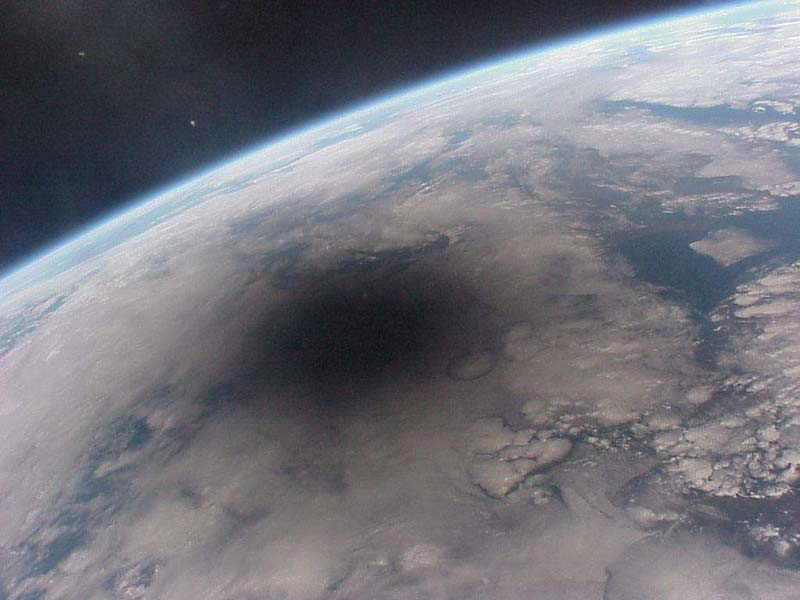Something strange happens during a solar eclipse. As the Moon’s shadow passes over the surface of the Earth, observers have noticed mysterious bands of shadow ripple ahead and behind the eclipse. It seemed possible that these bands were a result of constructive and destructive interference of sunlight around the limb of the Moon (an effect known as diffraction), or atmospheric turbulence may have had a part to play. However, a new theory has come to light. As the Moon’s shadow travels across the Earth’s surface, it may be possible that the shadow cools the atmosphere suddenly, creating a pressure difference. This gives rise to a sonic phenomenon: a shock front. This may refract the path of light from the lunar limb and through the atmosphere, creating the bands of light and dark. The solar eclipse may be a sonic phenomenon as well as an optical one…
If an object travels faster than the speed of sound, a shock will form. This shock is generated as a body passes through the atmosphere faster than sound can propagate. On Earth, at sea level, the speed of sound is approximately 1,225 kilometres per hour (or 761 miles per hour; i.e. the sound of an explosion would take an hour to travel a distance of 761 miles). Should an aircraft travel at 1,225 km/hr or beyond, the pressure waves it generates cannot keep up with the plane. In this case, a shock wave will form, more commonly known as a “sonic boom” for stationary observers.
So, back to the solar eclipse. How can the shadow of the Moon create a sonic boom? It’s only a shadow, it’s not a solid body moving inside the atmosphere; surely a shock isn’t possible? Actually, research carried out by astrophysicist Dr Stuart Eves who works with the Surrey Satellite Technology Limited (SSTL) suggests it may be possible, and the phenomenon produced is known as “infrasound”. He believes that as the lunar shadow passes over the Earth’s surface, there is intense, local cooling of the atmosphere after the leading and before trailing edge of the eclipse. This cooling sets up a sudden pressure difference.
“As the eclipse shadow moves through the atmosphere, the sudden disappearance of the Sun changes the Earth’s temperature.” – Dr Eves.
If we consider that the eclipse shadow travels at supersonic velocities (1,100 miles per hour at the equator and up to 5,000 miles per hour near the poles), and the strong pressure gradient travels with the eclipse, a shock front is created in the atmosphere, generating infrasound waves. The sub-audible infrasound generated by this occurrence modifies the atmosphere to such an extent that it will deflect the path of light through the atmosphere. In this case, the light and dark bands around the eclipse shadow would be created by refraction.
Some scientists are sceptical about this new theory, but Eves thinks his explanation may also help to explain other phenomena during eclipses. Infrasound may be responsible for strange Foucault pendulum behaviour (the sensitive pendulums – used to demonstrate the rotation of the Earth – swing wildly during eclipses). The infrasound pulses may cause the ground to vibrate, interfering with the pendulum swing. Infrasound may also explain some bizarre animal behaviour during these events. Sub audible sound wave frequencies are known to distress or alarm birds, perhaps their strange behaviour during eclipses could be down to infrasound propagation.
Source: BBC


Hi Daniel. Actually, there has been some confusion surrounding the bands as the previous research only explains one aspect of the phenomenon. The next step would be to find a way to measure the infrasound possibly generated during the next eclipse. This is what science is all about, don’t go discounting this new theory quite yet…
Try again…The moon is acting as a gravitational lens of the sun, harmonizing the atmosphere with waves of space/time.
Interesting and relatively easy to test in the next solar eclipse.
Unfortunately the paper the BBC story is based on is hard to track down, but on the Solar Eclipse Mailing List the new work isn’t taken serious very much anyway – because the shadow band phenomenon was already explained in 1986 to most everyone’s satisfaction. It is certainly not “mysterious” as the BBC writer claims.
Sounds reasonable. Let’s get some weather balloons or sounding rockets up there and see!
Also sounds like a good explanation for the Foucault pendulum phenomenon.
Could you please give a reference for the claim about Foucault pendulums?
I like the infrasound idea. I have been sensitive to it in the past.
The Foulault pendulum behaviour was described in a New Scientist cover story, entitled “Einstein Eclipsed”, which was published in November 2004. That article proposes a gravitational explanation of the phenomenon.